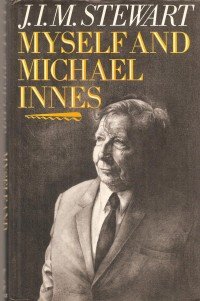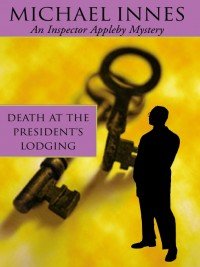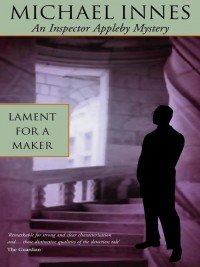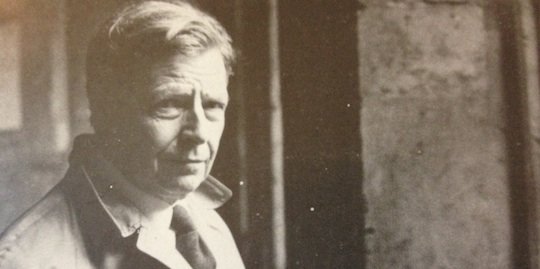He’s one of the longest-serving literary detectives, but do lovers of classic crime still read the extravagant, erudite novels featuring Inspector John Appleby? Have crime readers even heard of Michael Innes, the pen name adopted by Scottish academic and author John Innes Mackintosh Stewart (1906-1994) for his donnish detective fiction? Fortunately, his books are still in print – and available as ebooks. If you can handle the author’s quirks – including a tendency to keep his detective off the stage – the playful, clever and sometimes baffling novels of Michael Innes deserve to be discovered.
He was described as a farceur by crime critic Julian Symons, a reference to the fact that Innes found the business of fictional murder endlessly amusing. In fact, his tricksy prose and in-jokes were a reaction against the ‘comfortable bafflement’ he found in Golden Age authors such as Agatha Christie. In 1936, he created Inspector Appleby, a scholarly type of detective in the Metropolitan Police, whose unique abilities are often employed beyond London in country houses, ancient colleges and even a Pacific island. His final adventure, Appleby and the Ospreys, appeared in 1986 – a half-century of literary detection not far off Poirot’s 55-year run.
 In Myself and Michael Innes: A Memoir (1987), Stewart was a little disdainful of his adopted genre sideline – he also wrote literary novels – and described its limitations and artificial nature. As he explained: “The novelist lurking in Michael Innes has coped with this situation as he can: preserving always a certain lightness of air in his writing: aerating it with such wit as he can command; escaping from the artificial into the fantastical or farcical.”
In Myself and Michael Innes: A Memoir (1987), Stewart was a little disdainful of his adopted genre sideline – he also wrote literary novels – and described its limitations and artificial nature. As he explained: “The novelist lurking in Michael Innes has coped with this situation as he can: preserving always a certain lightness of air in his writing: aerating it with such wit as he can command; escaping from the artificial into the fantastical or farcical.”
The following four novels certainly live up to his personal manifesto for the detective novel.
Death at the President’s Lodging (1936)
For his debut outing, Appleby returns to his Alma Mater, St Anthony’s College, a fictional institution modelled on an ancient university like Oxford, where Stewart was an English student and a professor. The president has been murdered and ancient bones discarded around the body. The main suspects are several Fellows who had keys to the exterior door onto the grounds of the lodging. As an academic himself, Innes revels in the rivalries, slights and eccentricities in which his characters indulge and captures the atmosphere where dons talk donnishly and undergraduates are routinely high-spirited, as he described it in his autobiography.
 This might have been a fairly typical crime novel of the 1930s but for the élan of Innes, whose self-aware prose is bursting with in-jokes and philosophical asides. Appleby pairs up with an academic, Giles Gott, who has a shameful sideline in detective novels (Stewart’s clearly anticipating digs from real-life colleagues). Gott’s pseudonymous novel Murder among the Stalactites is popular with a student, who teams up with a pair of chums on a parallel investigation that involves a thrilling 1930s car chase and a pursuit through a maze. The student trio’s whimsical detective effort is a joyous element that has a Gallic echo in Fred Vargas’s The Three Evangelists, published 60 years later. Death at the President’s Lodging is certainly a period piece – characters talk of there being a ‘queer business’ and Innes doesn’t allow women to intrude on his story – but it fizzes with literary verve and features an admirably intricate plot.
This might have been a fairly typical crime novel of the 1930s but for the élan of Innes, whose self-aware prose is bursting with in-jokes and philosophical asides. Appleby pairs up with an academic, Giles Gott, who has a shameful sideline in detective novels (Stewart’s clearly anticipating digs from real-life colleagues). Gott’s pseudonymous novel Murder among the Stalactites is popular with a student, who teams up with a pair of chums on a parallel investigation that involves a thrilling 1930s car chase and a pursuit through a maze. The student trio’s whimsical detective effort is a joyous element that has a Gallic echo in Fred Vargas’s The Three Evangelists, published 60 years later. Death at the President’s Lodging is certainly a period piece – characters talk of there being a ‘queer business’ and Innes doesn’t allow women to intrude on his story – but it fizzes with literary verve and features an admirably intricate plot.
Buy now on Amazon
Hamlet, Revenge! (1937)
The Lord Chancellor of England is murdered while playing Polonius in an amateur performance of Hamlet at stately home Scamnum Court. It follows a series of oblique threats employing Shakespearean phrases received by several performers. Appleby has to navigate this social minefield with care, though there’s a friendly face: Giles Gott, an academic with a penchant for penning intricate detective novels – Poison Haddock is his latest effort. Gott’s masterminded this production and it’s the Elizabethan staging involving different levels and trap doors that assists the murderer in shooting the Lord Chancellor and possibly swiping a secret document. During this fraught period for international relations, there’s a suspicion that spies are abroad in the English countryside.
 Appleby’s arrival displays some of Innes’s most audacious writing. After an evening at the ballet, he arrives home to find the prime minister with a mission and is whisked towards the scene of the crime in a fire engine (the PM finds this siren more agreeable than a police car). Appleby investigates murder, spies and safe cracking and there’s the possibility that Hamlet is a key part of the murderer’s motivation. Innes is adept at handling his cast of suspects without confusing the reader and there are some slippery twists of which a contemporary crime writer would be proud.
Appleby’s arrival displays some of Innes’s most audacious writing. After an evening at the ballet, he arrives home to find the prime minister with a mission and is whisked towards the scene of the crime in a fire engine (the PM finds this siren more agreeable than a police car). Appleby investigates murder, spies and safe cracking and there’s the possibility that Hamlet is a key part of the murderer’s motivation. Innes is adept at handling his cast of suspects without confusing the reader and there are some slippery twists of which a contemporary crime writer would be proud.
Buy now on Amazon
Lament for a Maker (1938)
The third novel by Innes is a remarkable combination of gothic horror and literary thriller with an obvious debt to Robert Louis Stevenson. Set in a fictional district of Scottish hamlets, it begins like a 1930s version of Trainspotting with a local shoemaker’s account in an authentic dialect of the bizarre events that have occurred during a snowbound Christmas. The mad recluse Ranald Guthrie, the laird of Erchany, has fallen from the ramparts of his castle on a stormy winter night. A crime appears to have been committed but few will mourn the passing of the miserly laird, who was in thrall to a clannish feud going back centuries.
 Noel Gylby, a literary charmer who appeared in Hamlet, Revenge!, takes up the second part of the narrative having become embroiled in events at the castle along with an American girl he met following a comical car crash. There’s certainly a light-hearted tone to Noel’s narrative as he mocks the laird’s charmless henchman and chilly Scottish castle. But the presence of rats adds a chilling note of horror, while the snow creates a mood of suspense as the castle becomes cut off from the outside world. Lament For a Maker doesn’t rely on twists so much as rival solutions, with Appleby appearing late in the day to explain not just the death of Guthrie but also rumours of his ghost roaming the district with mutilated fingers. It’s an evocative, baffling thriller that still has room for some witty scenes.
Noel Gylby, a literary charmer who appeared in Hamlet, Revenge!, takes up the second part of the narrative having become embroiled in events at the castle along with an American girl he met following a comical car crash. There’s certainly a light-hearted tone to Noel’s narrative as he mocks the laird’s charmless henchman and chilly Scottish castle. But the presence of rats adds a chilling note of horror, while the snow creates a mood of suspense as the castle becomes cut off from the outside world. Lament For a Maker doesn’t rely on twists so much as rival solutions, with Appleby appearing late in the day to explain not just the death of Guthrie but also rumours of his ghost roaming the district with mutilated fingers. It’s an evocative, baffling thriller that still has room for some witty scenes.
Buy now on Amazon
Appleby on Ararat (1941)
The author described this as one of his stories that brings ‘a little fantasy and fun into the detective story.’ Unfortunately, it also brings a fair amount of casual racism that must have offended plenty of readers even 72 years ago. Appleby is on a cruise in the South Pacific when the boat is torpedoed and he ends up floating on the inverted sun deck café with several other survivors. Within the first few dozen pages of this surreal novel, Innes throws everything at the story from shipwrecks and storms to the threat of cannibalism and the murder of Sir Ponto Unumunu, one of the survivors, on the strange island where they take refuge.
 Appleby on Ararat is a bit like an episode of TV drama Lost set during WWII and it’s not the place to start reading Innes. The characters are paper-thin but the story does hot up and, while it’s all fairly implausible, it’s a curious wartime adventure that takes Appleby out of his comfort zone.
Appleby on Ararat is a bit like an episode of TV drama Lost set during WWII and it’s not the place to start reading Innes. The characters are paper-thin but the story does hot up and, while it’s all fairly implausible, it’s a curious wartime adventure that takes Appleby out of his comfort zone.
Buy now on Amazon
In conclusion…
It’s fair to say that Innes may have been an uneven writer, but he reinvigorated the genre and influenced authors such as Bruce Montgomery whose pseudonym, Edmund Crispin, and detective don character, Gervase Fen, came from the character Gervase Crispin in Hamlet, Revenge! Colin Dexter may well have been a fan judging by the murderous dons and literary allusions in the Inspector Morse novels. And science fiction author Adam Roberts recently published Jack Glass, a clever homage to Innes set in the far future.
Innes is not widely known today and isn’t even mentioned in 2007’s Rough Guide to Crime Fiction. He’s certainly an acquired taste, but his singular style and exuberant stories shouldn’t be forgotten.










I quite enjoy Michael Innes’ books but I have to be in the right mood for them. His language can be pedantic and they are definitely “of their time” – i.e. on the snobbish/sexist/racist side!
I strongly disagree that innes was racist, sexist or least of all snobbish. His writing g was of his time which means some language which would not be used today. That said, he includes some women characters who are intelligent, educated and brave. Various passages make it clear that while he liked to set his mysteries among the landed and titled classes, he had no special reverence for them.
True his vocabulary can be a problem for many readers and at times his praise is almost as convoluted as henry James. His work was also quite uneven with the best stuff published in the forties and fifties.
But he combined a unique set of qualities. He was extremely intelligent and learned with a wild imagination and extraordinary sense of humor, as well as being a profoundly humane person. He is one of my very favorite authors and I have read many of his books many times.
Correction. His PROSE is convoluted, not his PRAISE.
No other crime author I can think of took such joy from playing with the english language (not even Edmund Crispin), and his command of subtle meaning was – and is – second to none. Though not an Appleby story, his Christmas at Candleshoe remains one of my absolute favourite novels.
Few novelists have or have had the talent of such exuberant interweaving of sweeping literary knowledge within brilliant phraseology into narrative. Try “Old Hall, New Hall” for a sparkling, droll and exquisitely crafted novel, which is both an enchantment and a mystery. Only Derek Marlowe of a succeeding generation comes close.
I am happy to know that I am not the only one that enjoy Michael Innes. His descriptive language and understated humour make me come back to his books again and again.
My favorites are From London Far and Applebys End.